Trichocereinae
Trichocereinae is a subtribe of cactus that are particular to South America.[1] There are 28 recognized genera in this subtribe.
| Trichocereinae | |
|---|---|
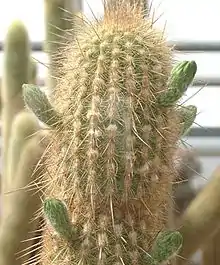 | |
| Haageocereus pacalaensis of the tribe Trichocereeae. | |
| Scientific classification | |
| Kingdom: | Plantae |
| Clade: | Tracheophytes |
| Clade: | Angiosperms |
| Clade: | Eudicots |
| Order: | Caryophyllales |
| Family: | Cactaceae |
| Subfamily: | Cactoideae |
| Tribe: | Cereeae |
| Subtribe: | Trichocereinae Buxb. (1958) |
| Type genus | |
| Trichocereus | |
| Genera | |
|
See text | |
Description
Arborescent to shrubby, Trichocereinae normally form unsegmented, spherical to columnar stems that are usually ribbed, tuberculate, or ribbed-warty.
The small to fairly large, regular or bilaterally symmetrical flowers appear laterally or below the apex and open day or night. The flower cup is scaled or covered with hair.
The fruits are fleshy to berry-like and sometimes burst open lengthwise. They contain small to medium-sized seeds that vary in shape. Hilum and micropyle of seeds are fused to united. Appendages are usually absent. A strophic is present in some.[2]
Genera
The composition of the subtribes of the tribe Cereeae varies. The list below is based on genera accepted by Plants of the World Online as of October 2023[3] and placed in subtribe Trichocereinae by Lendel in 2013. Reicheocactus (listed here) was not included in Lendel's analysis, and was described as basal to the subtribe.[1]
| Image | Genus | Living species |
|---|---|---|
 | Acanthocalycium Backeb. 1936 |
|
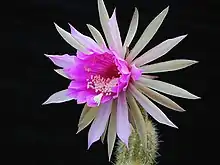 | Arthrocereus A.Berger 1929 |
|
 | Borzicactus Riccob. 1909 |
|
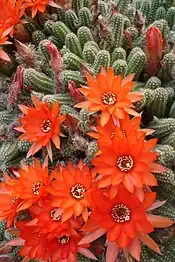 | Chamaecereus Britton & Rose 1922 |
|
.jpg.webp) | Cleistocactus Lem. 1861 |
|
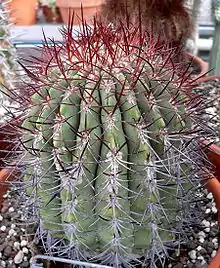 | Denmoza Britton & Rose 1922 |
|
.jpg.webp) | Echinopsis Zucc. 1837 |
|
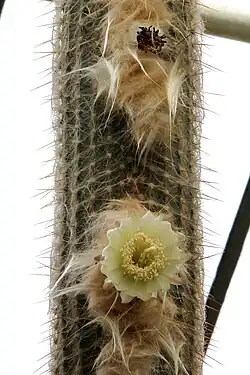 | Espostoa Britton & Rose 1920 |
|
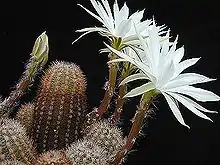 | Haageocereus Backeb. 1933 |
|
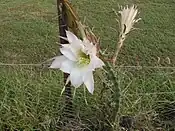 | Harrisia Britton 1908 publ. 1909 |
|
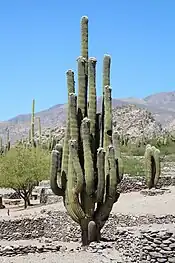 | Leucostele Backeb. 1953 |
|
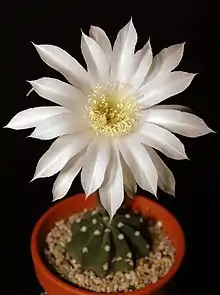 | Lobivia Britton & Rose 1922 |
|
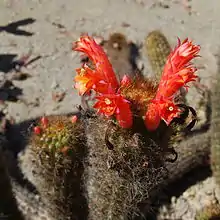 | Loxanthocereus Backeb. 1937 |
|
.jpg.webp) | Matucana Britton & Rose 1922 |
|
 | Mila Britton & Rose 1922 |
|
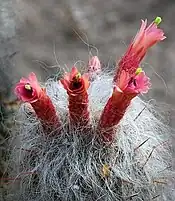 | Oreocereus Riccob. 1909 |
|
.jpg.webp) | Oroya Britton & Rose 1922 |
|
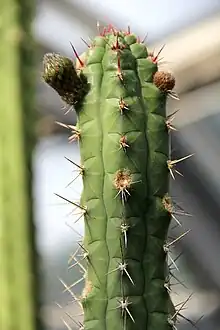 | Rauhocereus Backeb. 1956 publ. 1957 |
|
_-%E6%97%A5%E6%9C%AC%E5%A4%A7%E9%98%AA%E9%AE%AE%E8%8A%B1%E7%AB%B6%E6%94%BE%E9%A4%A8_Osaka_Sakuya_Konohana_Kan%252C_Japan-_(40360118800).jpg.webp) | Reicheocactus Backeb. 1942 |
|
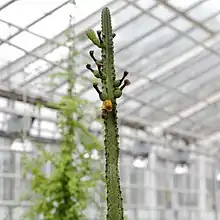 | Samaipaticereus Cárdenas 1952 |
|
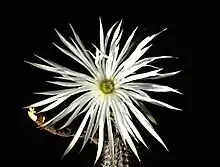 | Setiechinopsis Backeb. ex de Haas 1940 |
|
 | Soehrensia Backeb. 1938 |
|
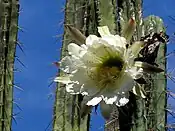 | Trichocereus (A.Berger) Riccob. 1909 |
|
_(34991631493).jpg.webp) | Vatricania Backeb. 1950 |
|
 | Weberbauerocereus Backeb. 1942 |
|
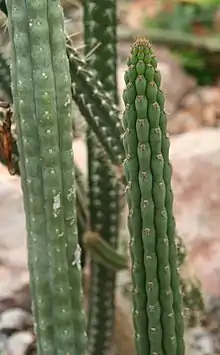 | Yungasocereus F.Ritter 1980 |
|
Intergeneric hybrids
Naturally occurring hybrids between genera in the subtribe include:
- × Borzicana M.H.J.van der Meer = Borzicactus × Matucana
- × Haagespostoa G.D.Rowley = Haageocereus × Espostoa
- × Leucomoza M.H.J.van der Meer = Denmoza × Leucostele
- × Oreonopsis G.D.Rowley = Echinopsis × Oreocereus
Artificial hybrids include:
- × Chamaelobivia Y.Itô = Chamaecyparis × Lobivia[4]
- × Trichopsis Y.Itô = Echinopsis × Trichocereus[5]
References
- Lendel, Anita (2013). South American Cacti in time and space: studies on the diversification of the tribe Cereeae, with particular focus on subtribe Trichocereinae (Cactaceae) (Dr. sc. nat. thesis). University of Zurich. doi:10.5167/UZH-93287. Retrieved 2023-10-10.
- Anderson, Edward F.; Eggli, Urs (2005). Das grosse Kakteen-Lexikon (in German). Stuttgart (Hohenheim): Ulmer. pp. 58–59. ISBN 3-8001-4573-1.
- "Cactaceae Juss". Plants of the World Online. The Trustees of the Royal Botanic Gardens, Kew. Retrieved 2023-10-10.
- "× Chamaelobivia Y.Itô". Plants of the World Online. Royal Botanic Gardens, Kew. Retrieved 2023-10-09.
- "× Trichopsis Y.Itô". Plants of the World Online. Royal Botanic Gardens, Kew. Retrieved 2023-10-10.
External links
- USDA, ARS, National Genetic Resources Program. Germplasm Resources Information Network - (GRIN). National Germplasm Resources Laboratory, Beltsville, Maryland, June 1, 2007.